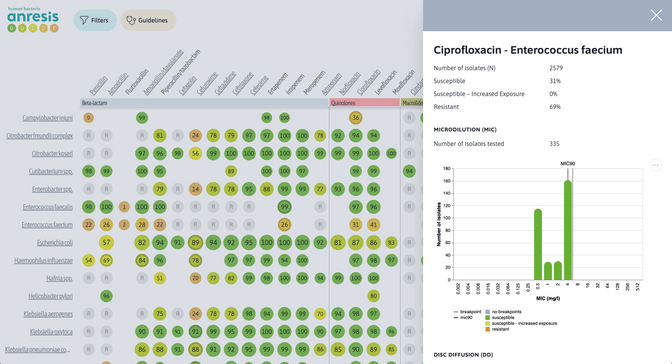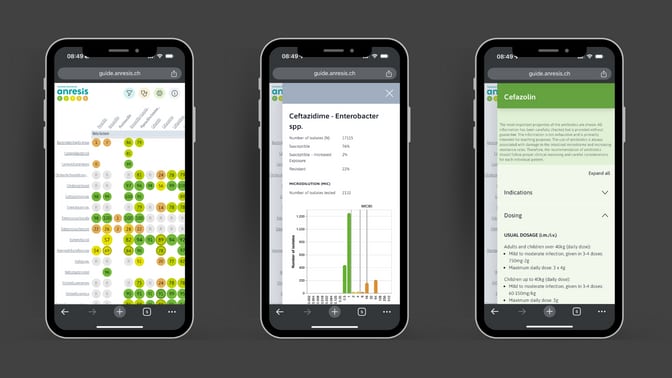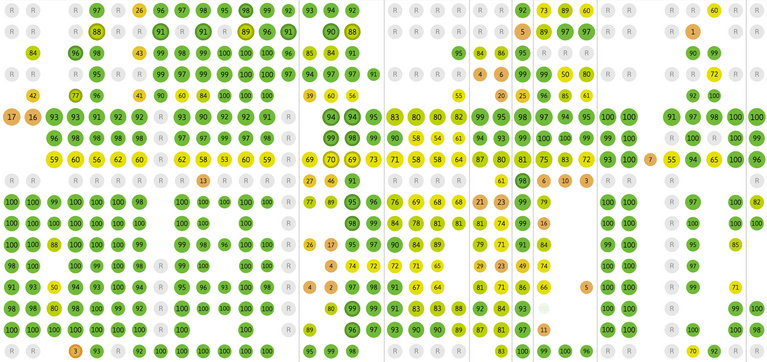The ANRESIS Guide is a digital platform developed by Prof. Andreas Kronenberg and his team at the Swiss Centre for Antibiotic Resistance, Institute for Infectious Diseases, University of Bern. Its purpose is to provide accessible and reliable antibiotic resistance data and guidelines.
The platform aims to assist healthcare professionals, particularly specialists and hospital physicians, in making informed decisions about antibiotic therapy.
Initially, the team had a static homepage that displayed limited data on antibiotic resistance trends. Prof. Andreas Kronenberg recognized the need to share more comprehensive data and make it easily accessible to healthcare professionals. The primary motivation was to promote prudent antibiotic use and combat the growing issue of antibiotic resistance.
From Data Complexity to Intuitive Interface
The ANRESIS Guide draws data from the ANRESIS database, managed by the Swiss Centre for Antibiotic Resistance. This database continuously collects information from 38 Swiss laboratories, covering 90% of hospitalized patients across the country. However, merely collecting data isn't enough; it needs to be made accessible and understandable for healthcare professionals.
This is where the ANRESIS Guide comes in. Our team took on the challenge of transforming this complex data into an intuitive and powerful visual tool. The centerpiece of the interface is an interactive matrix that displays susceptibility rates for the most important microorganism-antimicrobial combinations.
Cutting-Edge Data Visualization
The ANRESIS Guide interface is much more than a simple table of figures. Each circle in the matrix represents a specific microorganism-antimicrobial combination. The circle’s color indicates the susceptibility rate, ranging from green (susceptible) to red (resistant), while its size reflects the number of isolates tested. This visual approach allows physicians to quickly grasp resistance and patterns.
But we didn't stop there. By hovering over a circle, the user can see more details, including the confidence interval. Clicking on the circle reveals additional data, depicting the exact distribution of quantitative resistance data as MIC and DD. This feature offers depth of information while maintaining a clear and intuitive user interface.

Customization and Flexibility at the Heart of Design
Understanding that needs vary among users, we've integrated powerful customization options. Filters allow data to be restricted to different regions, patient types, or age groups. Users can also adjust the view to focus on certain microorganisms or antibiotics, or expand it to include rare microorganisms or last-resort antibiotics.
For individual hospitals, we've even provided the possibility to create local editions, allowing the definition of their own panels and guidelines. This flexibility ensures that the ANRESIS Guide can adapt to the specific needs of each institution.
Initially, the tool's adoption by students wasn’t expected. Consequently, we incorporated detailed information about microorganisms and antibiotics, encompassing knowledge Prof. Andreas Kronenberg and his team expect students to have mastered by the completion of their studies.
Beyond Data: A Decision Support Tool
The ANRESIS Guide doesn't just present data. It also incorporates guidelines providing a quick overview of recommended first- and second-line treatments for the most important infectious diseases. This feature transforms the tool from a mere data source into a true assistant for clinical decision-making.
Security and Updates: Absolute Priorities
In a field as sensitive as healthcare, data security and currency are paramount. The ANRESIS Guide data is automatically updated quarterly, ensuring that physicians always work with the most recent information.
Technology
We chose Django and Python to develop a custom backend tailored to the specific requirements of Prof. Andreas Kronenberg. This combination allowed us to efficiently address his unique needs.
Django's integrated back office proved ideal for Prof. Kronenberg's requirements. The core features of Django Admin, complemented by a few custom adjustments, enable him to easily manage data imports and editing.
For the frontend, our team opted for a single-page application (SPA) using Vue.js. This choice tackled two major challenges: ensuring optimal performance for displaying the ANRESIS matrix and providing a smooth user experience across all screen types.

Security
Regarding security, although the site is public and primarily contains information pre-aggregated before being stored on the ANRESIS guide server and accessible to everyone, we implemented essential security measures. These include securing the access points (endpoints) of the REST API provided by our backend and following web development best practices.
The Future of Combating Antibiotic Resistance
The ANRESIS Guide represents a giant leap in visualizing and interpreting antibiotic resistance data. By making this crucial information more accessible and understandable, we're contributing to more prudent and efficient use of antibiotics.
This project perfectly illustrates how technology can transform complex data into a practical and powerful tool for healthcare professionals. Thanks to its flexible and adaptable architecture, specialists are now able to present their data using this tool.
In an era where data visualization is becoming increasingly critical, ANRESIS Guide is leading the way toward better medical data comprehension and application.
Do you have questions on this project or on how data vizualisation tools could help you? Do not hesitate to contact me, I will be happy to discuss it with you.

